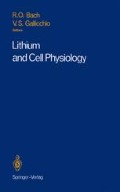Abstract
One of the major dominant themes in cell biology is elucidating at the molecular level the mechanisms by which alterations in the external microenvironment influence the proliferation of mammalian cells. It is a well-described phenomenon that a number of agents or conditions markedly influence the rate of cellular proliferation. Hormones, serum or growth factors, when added to cultures of quiescent cells in a short period of time, all can induce a number of metabolic changes leading to the initiation of DNA synthesis and cell division (1–4). These substances are thought to act via their interaction with the cell membrane by the activation of a second signal that is transmitted into the interior of these cells (5–7). In the absence of these factors mammalian cells stop proliferating and enter a phase referred to as the resting phase of Gl/Go, only to assume proliferation when the absent agent is resupplied.
Access this chapter
Tax calculation will be finalised at checkout
Purchases are for personal use only
Preview
Unable to display preview. Download preview PDF.
References
Holley, R.W., & Kiernan, J.A. (1968). “Contact inhibition” of cell division in 3T3 cells. PNAS, USA, 60, 300.
Hershko, A., Mamont, P., Schields, R., Tomkins, G.M. (1971). Nature (London), 232, 206.
Temin, H.M., Pierson, R.W., Jr., & Dulak, V.C. (1972). In G.H. Rothblat & V.J. Cristofalo (Eds.), Growth, nutrition and metabolism of cells in culture (pp. 50–81). New York: Academic Press.
Rudland, P.S., Seifert, W., & Gospodarowicz, D. (1974). Growth control in cultured mouse fibroblasts: Induction of the pleiotypic and mitogenic responses by a purified growth factor. PNAS, USA, 71, 2600.
Pardee, A.B., Jimenez de Asua, L., & Rosengurt, E. (1974). In B. Clarkson & R. Baserga (Eds.), Control of proliferation in animal cells (pp. 547–561). Cold Spring Harbor, NY: Cold Harbor Laboratory.
Rubin, H.A. (1978). Do viruses use calcium ions to shut off host cell functions? Nature (London), 271, 186.
McKeehan, W.L., & Ham, R.G. (1978). Calcium and magnesium ions and the regulation of multiplication in normal and transformed cells. Nature (London), 275, 756.
Sanui, H., & Rubin, H.A. (1978). Membrane bound and cellular cationic changes asociated with insulin stimulation of cultured cells. J. Cell Physiol., 96, 265.
Dulbecco, R., & Elkington, J. (1975). Induction of growth in resting fibroblastic cell cultures by Ca. J. PNAS, USA, 72, 1584.
Mamont, P.S., Bohlen, T., Milann, P., Bey, F., Schuber, F., & Tardif, C (1976). x-Methyl ornithine, a potent competitive inhibitor.pa of ornithine decarboxylase, blocks proliferation of rat hepatoma cells in culture. PNAS, USA, 73, 1626.
Hori, C., & Oka, T. (1979). Induction of lithium ion on multiplication of mouse mammary epithelium in culture. PNAS, USA, 76, 2823.
Ptashne, K., Stockdale, F., & Conlon, S. (1980). Initiation of DNA synthesis in mammary epithelium and mammary tumors by lithium ions. J. Cell Physiol., 103, 41.
Hart, D. (1979). Potentiation of phytohemagglutinin stimulation of lymphoid cells by lithium. Exp. Cell Res., 119, 47.
Pruss, R., & Herschman, H. (1979). Variants of 3T3 cells lacking mitogenic response to epidermal growth factor. PNAS, USA, 74, 3918.
Smith, J., & Rosengurt, E.J. (1978). Lithium transport by fibroblastic mouse cells: Characterization and stimulation by serum and growth factors in quiescent cultures. J. Cell Physiol., 97, 441.
Rozengurt, E., & Mendoza, S. (1980). Monovalent ion fluxes and the control of cell proliferation in cultured fibroblasts. Ann. NY Acad. Sci., 339, 175.
Frantz, C., Nathan, D., & Scher, C. (1981). Intracellular univalent cations and the regulation of the BALB lc-3T3 cell cycle. J. Cell Biol., 88, 51.
Toback, P. (1980). Induction of growth in kidney epithelial cells in culture by Na+. PNAS, USA, 77, 6654.
Clausen, T., Elbrink, J., & Martin, B. (1974). Insulin controlling calcium distribution in muscle and fat cells. Acta Endocrinol 77, suppl., 191, 137.
DeMeis, L. (1971). Alosteric inhibition by alkali ions of the Ca2+ uptake and adenosine triphosphatase activity of skeletal muscle microsomes. J. Biol Chem., 246, 4764.
Gelfand, E., Dosch, H., Hastings, D., Shore, A. (1979). Lithium: A Modulator of Cyclic AMP Dependent Events in Lymphocytes? Science 203, 365.
Dousa, T., & Hechter, O. (1970). The effect of NaCl & LiCl on vasopressin-sensitive adenyl cyclase. Life Sci., 9, 765.
Haugaard, E.S., Frazer, A., Mendels, J., & Haugaard, N. (1975). Metabolic and electrolyte changes produced by lithium ions in the isolated rat diaphragm. Biochem. Pharmacol., 24, 1187.
Mickel, R.A., Hallidy, L., Haugaard, N., & Haugaard, E.S. (1978). Stimulation by lithium ions of the incorporation of [u-14C] glucose into glycogen in rat brain slices. Biochem. Pharmacol., 27, 799.
Ryback, S.M., & Stockdale, F.E. (1981). Growth effects of lithium chloride in BALB/c-3T3 fibroblasts and Madin-Darby canine kidney epithelial cells. Exper. Cell Res., 136, 263.
Manku, M.S., Horrobin, D.F., & Karmazyn, M. (1979). Prolactin and zinc effects on rat vascular reactivity: Possible relationship to dihomo-γ-linolenic acid and to prostaglandin synthesis. Endocrinology, 104, 114.
Editor information
Editors and Affiliations
Rights and permissions
Copyright information
© 1990 Springer-Verlag New York Inc.
About this chapter
Cite this chapter
Gallicchio, V.S. (1990). Effects of Lithium on Cell Growth. In: Bach, R.O., Gallicchio, V.S. (eds) Lithium and Cell Physiology. Springer, New York, NY. https://doi.org/10.1007/978-1-4612-3324-4_9
Download citation
DOI: https://doi.org/10.1007/978-1-4612-3324-4_9
Publisher Name: Springer, New York, NY
Print ISBN: 978-1-4612-7967-9
Online ISBN: 978-1-4612-3324-4
eBook Packages: Springer Book Archive

